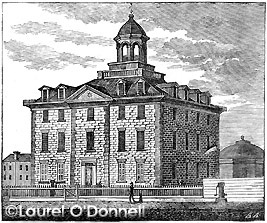|
|
Chapter III
Important Incidents of the Revolution
and Later History of Manhattan. New York Government at Sea—Plot to Assassinate Washington—Shocking Barbarity of English Officers—Hale and André, the Two Spies—Arnold in New York—British Evacuation—The Burr and Hamilty Tragedy of 1804—Robert Fulton and the “Clermont“—Public Improvements of 1825.
Shocking Barbarity of English Officers
The condition of the captured soldiers of the Continental army, and of many of the inhabitants of New York, during the Revolutionary period, presents one of the most melancholy chapters of human suffering in the history of the world. The several churches were converted into prisons, hospitals, military depots, and riding schools. The Bridewell, in its half-finished condition, the new jail, sugar-houses, and various prison-ships, were filled with soldiers and political prisoners promiscuously huddled together. In winter, without fire or blankets, they perished with cold, and in summer they suffocated with heat. In the burning season every aperture in the walls was crowded with human heads, panting for a breath of the outside world,  Old Provost, New York. while the ghastly eye turned anxiously from the misery and death within, in quest of a green leaf or a friendly countenance. Sick, wounded, and healthy lay on the same floor, rendered putrid with filth, and vocal with the sounds of human agony. Jailers and guards exhibited a love of cruelty horrid beyond expression, and many are said to have been poisoned by these fiendish attendants for their watches and silver buckles. They were not regarded as prisoners of war, but as pinioned rebels, to be starved and tortured until killed or goaded into the royal army. While a few remonstrated against these shocking inhumanities, the friends of the ministry cried out, "Starvation, Starvation to the Rebels; nothing but starvation will bring them to their senses."
The old sugar-house, one of the chief dens of human torture, was constructed of gray stone, and stood in Liberty street, east of Nassau, and immediately adjoining the Middle Dutch Church, or what is now the old New York Post-office. This sugar refinery, erected in 1689, had passed through an honorable career from the days of Leisler downward in its legitimate use, but was now, under foreign rule, destined to depart from the good old way; its sweetness to be changed to gall and bitterness, and its cheerful business hum to the sighs and wails of the suffering and starving. The edifice contained five low stories which were each divided into two rooms. The walls were very heavy, and the windows small and deep. The yard was encircled with a close board-fence nine feet high. Within these walls were at times huddled 400 or 500 prisoners of war, without beds, blankets, or fire in winter, wearing for months the filthy garments that covered them on the day of their capture. Hot weather came, and with it the typhus fever, which prevailed fearfully, filling the dead cart on each returning morning with wrecks of wasted humanity, which were rudely dumped in the trenches in the outskirts of the city. The meagre diet of these suffering patriots consisted of pork and sea biscuit; the latter, having been damaged by salt water, were consequently very mouldy, and much worm-eaten. |
|
34
:: Previous Page :: Next Page ::
Books & articles appearing here are modified adaptations
from a private collection of vintage books & magazines. Reproduction of these pages is prohibited without written permission. © Laurel O’Donnell, 1996-2006.
|
|